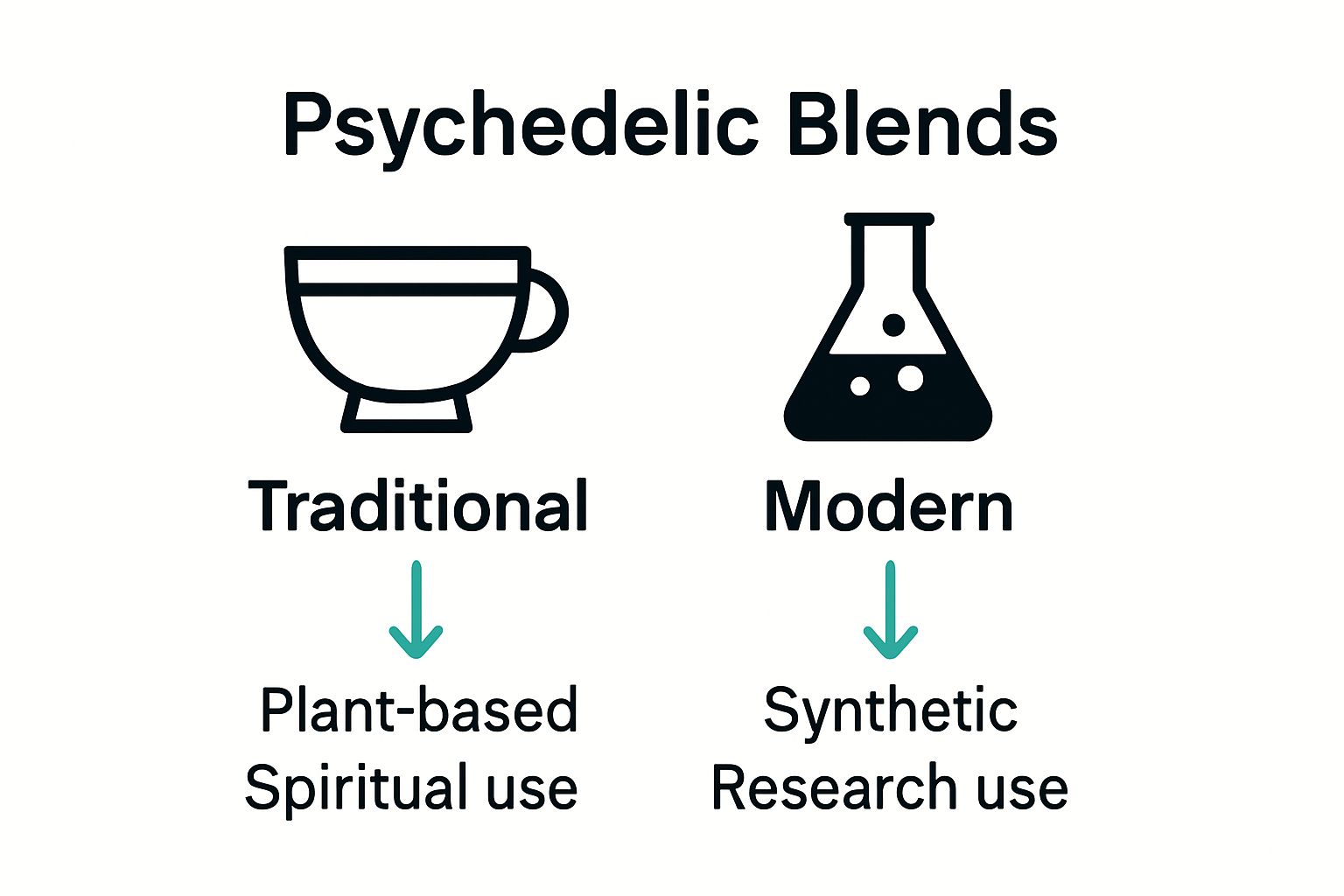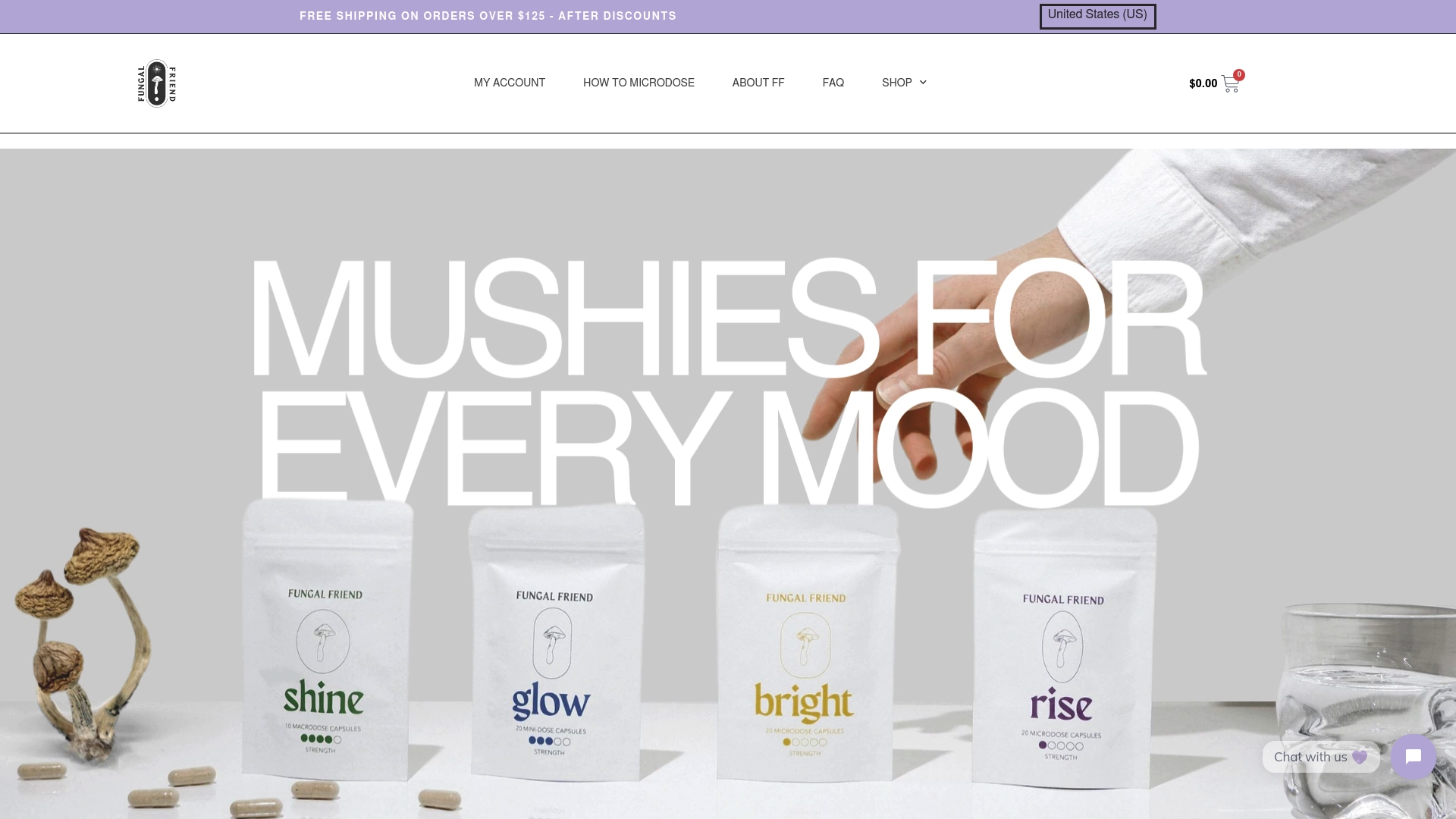Understanding the Effects of Psychedelic Blends
Psychedelic blends are shaking up how people approach consciousness and mental health. Some blends combine psilocybin, LSD, and ancient plant compounds in a single dose, sparking effects that scientists say can dramatically rewire the brain’s networks. That might sound like a recipe for chaos or danger. Yet these carefully crafted combinations are not chaotic at all. Instead, they have opened doors to new forms of therapy and self discovery that single substances could never provide.
Table of Contents
- What Are Psychedelic Blends And Their Components?
- Why Do People Use Psychedelic Blends?
- How Psychedelic Blends Work On The Brain
- Potential Benefits And Risks Of Psychedelic Blends
- Exploring Different Types Of Psychedelic Blends
Quick Summary
| Takeaway | Explanation |
|---|---|
| Psychedelic blends enhance psychological experiences | These mixtures offer unique interactions that can alter perception and consciousness significantly. |
| Diverse components influence effects | Blends incorporate various natural and synthetic substances, targeting neurotransmitter systems for complex outcomes. |
| Used for mental health therapy | Many seek these blends to address challenging conditions like treatment-resistant depression through alternative methods. |
| Inherent risks require caution | Understanding potential psychological risks is critical, including intense emotional responses and individual variability. |
| Blends vary from traditional to modern | Both ceremonial and contemporary mixtures explore consciousness in diverse ways, expanding therapeutic potentials. |
What Are Psychedelic Blends and Their Components?
Psychedelic blends represent complex combinations of psychoactive substances designed to produce unique neurological and psychological experiences. These intentionally crafted mixtures go beyond traditional single-substance approaches, offering nuanced interactions between different chemical compounds that can profoundly influence consciousness and perception.
Defining Psychedelic Blends
At their core, psychedelic blends are strategic combinations of substances that interact with the brain’s neurotransmitter systems, particularly serotonin receptors. Research from the National Center for Biotechnology Information reveals these blends typically incorporate multiple psychoactive elements like psilocybin, LSD, and plant-derived compounds such as harmala alkaloids.
Key characteristics of psychedelic blends include:
- Intentional synergy between different chemical compounds
- Targeted neurological interactions
- Potential for enhanced or modulated psychedelic experiences
Chemical Composition and Interactions
The composition of psychedelic blends often involves intricate combinations of chemical classes, including:
- Tryptamines: Natural compounds like DMT and psilocybin
- Phenethylamines: Substances such as mescaline
- Synthetic and plant-derived psychoactive molecules
Each component contributes unique properties, creating a complex pharmacological profile that can produce sophisticated neurological responses.
This table summarizes the primary components found in psychedelic blends, their chemical class, and their core effects on the mind and body based on the article’s information.
| Component | Chemical Class | Source | Primary Effects |
|---|---|---|---|
| Psilocybin | Tryptamine | Mushrooms | Altered perception, enhanced introspection |
| LSD | Lysergamide | Synthetic | Intense sensory changes, cognitive expansion |
| DMT | Tryptamine | Plants, synthetic | Profound visual and emotional experiences |
| Harmala Alkaloids | Beta-carboline | Plants (Ayahuasca vine) | MAOI effect, extends DMT/tryptamine action |
| Mescaline | Phenethylamine | Cacti (San Pedro, Peyote) | Altered mood, perceptual shifts |
| Synthetic Blends | Variable | Lab-created compounds | Targeted neurological or therapeutic effects |
| Scientific research from Frontiers in Pharmacology demonstrates how these interactions can significantly modify perception, mood, and cognitive processing. |
For those interested in understanding more about the scientific foundations, read our detailed guide on understanding psychedelics for mental clarity.
Why Do People Use Psychedelic Blends?
People explore psychedelic blends for a complex range of personal, therapeutic, and transformative reasons. These intentional combinations of substances offer pathways to understanding consciousness, addressing mental health challenges, and expanding psychological boundaries beyond traditional treatment approaches.
Mental Health and Therapeutic Exploration
Many individuals turn to psychedelic blends as alternative approaches to managing mental health conditions. Research from traditional ceremonial practices demonstrates how carefully constructed substance combinations can provide profound psychological insights and potential therapeutic benefits.
Key motivations for using psychedelic blends include:
- Addressing treatment resistant depression
- Exploring personal psychological landscapes
- Potential neurological reset and emotional processing
- Spiritual and introspective experiences
Performance and Personal Growth
Beyond therapeutic applications, psychedelic blends represent powerful tools for personal transformation. Individuals seek these experiences to:
- Enhance cognitive flexibility
- Break entrenched psychological patterns
- Explore alternative states of consciousness
- Gain novel perspectives on personal challenges
The neurological interactions within these blends can facilitate unique opportunities for self reflection and psychological reorganization. Our guide on understanding therapeutic uses of psilocybin offers deeper insights into how these substances interact with human consciousness.
While individual experiences vary dramatically, the underlying motivation remains consistent: a deep human desire to understand oneself and expand the boundaries of perception and experience.
How Psychedelic Blends Work on the Brain
Psychedelic blends represent sophisticated neurochemical interactions that profoundly transform brain functioning, creating complex alterations in perception, consciousness, and neural connectivity. These intricate molecular interactions go far beyond simple neurotransmitter stimulation, offering a nuanced approach to understanding brain plasticity and psychological experience.
Neuroreceptor Interactions
At the molecular level, psychedelic blends primarily target serotonin receptors, particularly the 5HT2A receptors, which play a crucial role in modulating neural communication. Research from neuroscience frontiers reveals that these substances can increase brain network entropy, leading to unprecedented neural connectivity and potential psychological insights.
Key neurological mechanisms include:
- Disruption of default mode network patterns
- Enhanced cross communication between brain regions
- Temporary reduction of cognitive rigidity
- Increased neuroplasticity
Brain Network Reconfiguration
Psychedelic blends facilitate remarkable brain network reorganization, allowing individuals to experience consciousness from fundamentally different perspectives. The complex interactions between various compounds can trigger:
- Temporary dissolution of ego boundaries
- Alternative perceptual processing
- Activation of dormant neural pathways
- Potential emotional and psychological reframing
Learn more about how psilocybin interacts with brain chemistry to understand the intricate neurological transformations these substances can facilitate. The brain essentially becomes a dynamic, fluid system capable of unprecedented levels of introspection and cognitive flexibility during these experiences.

Potential Benefits and Risks of Psychedelic Blends
Psychedelic blends represent a complex landscape of potential therapeutic opportunities and inherent psychological risks. Understanding these nuanced interactions requires a comprehensive approach that balances scientific insight with individual variability and careful consideration.
Therapeutic Potential and Psychological Benefits
Research from JAMA Psychiatry suggests that psychedelic blends can offer profound therapeutic potential, particularly for treatment resistant mental health conditions. These combinations may provide more targeted and comprehensive psychological interventions compared to traditional single compound approaches.
Potential psychological and therapeutic benefits include:
- Enhanced emotional processing
- Reduction of treatment resistant depression symptoms
- Increased neuroplasticity
- Potential breakthrough in trauma recovery
- Expanded consciousness and self understanding
Risks and Psychological Considerations
While promising, psychedelic blends also carry significant psychological risks that demand careful navigation. Scientific research highlights potential complications such as serotonin syndrome, psychological distress, and unpredictable neurochemical interactions.
Key risks and considerations include:
- Potential for intense psychological experiences
- Risk of exacerbating underlying mental health conditions
- Possible temporary ego dissolution
- Complex neurochemical interactions
- Individual variability in response
Explore our comprehensive guide on psilocybin health benefits to understand the nuanced landscape of psychedelic therapeutic potential. Responsible exploration requires a balanced approach that respects both the transformative potential and inherent complexity of these powerful substances.
Exploring Different Types of Psychedelic Blends
Psychedelic blends represent a diverse and complex landscape of chemical interactions, ranging from traditional ceremonial mixtures to contemporary experimental combinations. These intricate formulations offer unique pathways for exploring consciousness, therapeutic potential, and personal transformation.
Traditional Ceremonial Blends
Research from ethnopharmacological studies reveals fascinating traditional psychedelic combinations that have been used for centuries in cultural and spiritual contexts. These ancient blends often involve sophisticated interactions between multiple plant based compounds designed to produce profound psychological experiences.
Traditional psychedelic blends include:
- Ayahuasca (DMT with MAOI containing plants)
- San Pedro cactus and tobacco combinations
- Amazonian shamanic plant mixtures
- Indigenous ceremonial smoke blends
- Ritualistic herbal psychoactive preparations
Modern Experimental Combinations
Contemporary psychedelic exploration has expanded beyond traditional boundaries, introducing complex synthetic and natural compound interactions. These modern blends often combine multiple substances to create targeted neurological experiences, exploring the intricate landscapes of consciousness and psychological potential.
Modern psychedelic blend categories include:
- Synthetic psychedelic combinations
- Integrated microdosing protocols
- Multicompound neurological exploration blends
- Therapeutic research combinations
- Personalized neurochemical interaction experiments
Check out our guide to magic mushroom chocolate varieties to understand how modern formulations are expanding the boundaries of psychedelic experiences. The evolution of psychedelic blends continues to challenge our understanding of consciousness, offering unprecedented opportunities for personal and scientific exploration.
The following table compares traditional ceremonial blends and modern experimental combinations, highlighting their distinct characteristics and purposes as outlined in the article.
| Type of Psychedelic Blend | Key Characteristics | Typical Components | Purpose & Context |
|---|---|---|---|
| Traditional Ceremonial Blends | Rooted in centuries-old spiritual or cultural rituals | Plant-based compounds (Ayahuasca, San Pedro) | Spiritual, communal, healing ceremonies |
| Modern Experimental Combinations | Developed through contemporary scientific exploration | Synthetic & natural substances, microdosing | Therapeutic research, personal discovery |
| Sophisticated interactions between multiple plant compounds | Herbals, shamanic mixtures, smoke blends | Expanding consciousness in ritual settings | |
| Often tailored to enhance specific neurological effects | Integrated multi-compound protocols | Controlled laboratory or personal use |

Ready to Experience the Real Power of Psychedelic Blends?
Curious about how psychedelic blends affect your mind and mood? You are not alone. Many readers just like you are searching for ways to manage anxiety, enhance focus, and tap into deeper personal growth using thoughtfully crafted psychedelic combinations. If you want scientifically-inspired solutions that go beyond theory—offering real support for mental clarity and emotional balance—your journey does not have to stop with this article. Check our Uncategorized Archives – Fungal Friend for more insights explaining different blend profiles and their effects.

Explore our curated range of microdose mushroom blends, psilocybin-infused teas, and magic mushroom chocolates specifically designed for safe, controlled experiences. Visit Fungal Friend today and discover legal products made for both first-timers and seasoned explorers. Take the next step now and choose a trusted Canadian source focused on education, safety, and your unique psychedelic goals.
Frequently Asked Questions
What are the primary effects of psychedelic blends on the brain?
Psychedelic blends primarily affect serotonin receptors, particularly the 5HT2A receptor, which can lead to altered perception and consciousness. To understand these effects better, consider noting any changes in mood or thought patterns during your experiences over a few sessions.
How do different components in psychedelic blends work together?
The components in psychedelic blends, such as tryptamines and phenethylamines, interact in complex ways to create a unique experience. To explore this, you can experiment with different combinations while maintaining a journal to track the effects of each blend on your perceptions and emotions.
What should I consider regarding the potential risks of using psychedelic blends?
Psychedelic blends can carry risks like psychological distress and unintended emotional reactions. Before use, evaluate your mental health history and consult a knowledgeable source to ensure a safer exploration experience.
How can I safely explore the therapeutic potential of psychedelic blends?
To safely explore their therapeutic potential, consider starting with lower doses in a controlled environment and focusing on your intent for the experience. Set clear goals for what you want to achieve, such as emotional insight or relaxation, and reflect on these goals afterward to assess your experience.
Can psychedelic blends offer benefits for someone with treatment-resistant depression?
Yes, psychedelic blends have shown promise in alleviating symptoms of treatment-resistant depression due to their ability to enhance emotional processing and neuroplasticity. If you are considering this route, collaborate with a mental health professional to monitor your progress and adjust as necessary within a few weeks.
How long do the effects of psychedelic blends last?
The effects of psychedelic blends can vary based on their composition, typically lasting from a few hours to a full day. To better gauge their duration, plan your experiences accordingly and allow yourself ample time for integration afterward.
